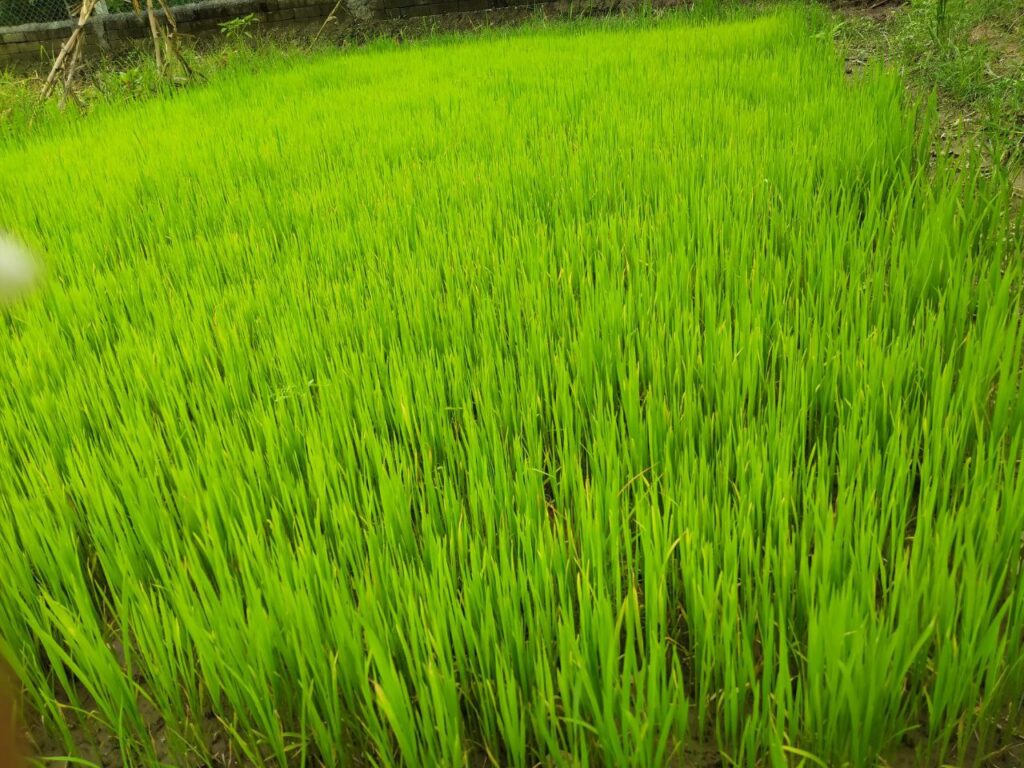
A nursery is a designated place for raising seedlings of transplanting crops in a small space, where the seedlings receive intensive care until they are ready to be transplanted to the main / actual field. Rice that is to be transplanted in lowland puddled soil must be initially grown on seedbeds.
Advantages of Rice Seedling raising
- Weed Control: Seedlings have a head start over weeds, minimising competition for nutrients, water, and light.
- Efficient Land Use: Seedbeds occupy less space, allowing for better management and efficient use of resources.
- Enhanced Seedling Health: Intensive nursery care promotes stronger, healthier seedlings that are best suited for transplanting.
- Uniform Growth: Seedlings grown in a controlled environment tend to be more uniform in size and development, leading to more consistent growth after transplanting.
- Reduced Seed Rate: Raising seedlings in nurseries often requires less seed compared to direct seeding methods.
- Pest and Disease Management: Easier monitoring and management of pests and diseases in a concentrated nursery area.
The basic practices involved in raising rice seedling in the nursery includes,
1. Seed treatment with fungicides :
Before soaking, pure and clean seeds should be treated with broad spectrum fungicide like carbendazim, captan, thiram @ 2-3 g/kg seed to protect against seed borne fungal disease. Treated seeds should be left for approximately 12 hours before soaking for incubation. Such treated seeds should be left for approximately 12 hours before soaking for incubation.

2. Soaking and Incubation :
Such treated seed should be dipped in fresh water to get bold and healthy seeds. Damaged and unfilled seeds float in the water whereas healthy seeds remain under the water surface. Soak the bold and healthy seeds for around 12-24 hours followed by incubation of seeds for around 36-48 hours in a jute bag/sack or on a cemented floor making heaps under shade conditions. After 36-48 hours pre-germinated seeds can be obtained.
3. Preparation of seedbed :

The area for the nursery bed should be selected near to the main transplanting land and also near to the irrigation source. The seedbed should be of 1-1.5m width and length as per the requirement and is raised 10-15 cm from the ground level in order to drain out the excess water during the rainy season. There should be a channel of 30-50 cm in between the seed beds which works for both irrigation and drainage. Deep ploughing, harrowing, planking, and levelling is conducted to prepare the nursery bed for seed sowing.Organic manure is incorporated into the soil 1-2 weeks before final seed bed preparation.
4. Sowing of seeds :
Around 50 kg seeds are required to be raised in a 500 m2 nursery area for transplanting about 1 ha main land. Generally, seeds are sown in the nursery bed by uniformly broadcasting them. The seeds can be slightly covered with soil after sowing or green mulching can also be done after sowing seeds in order to conserve soil moisture.
5. Manuring and fertilization :
Generally, farmers only apply organic manures while raising rice seedlings in the nursery bed. But it is necessary to provide inorganic fertilizers as per the requirement for obtaining healthy seedlings. Given the short duration of crop growth in the nursery bed (approximately 25-30 days), top dressing with nitrogenous fertilizers is essential for a prompt response. The first top dressing is applied at 8-10 days after sowing (DAS), using either 2.5 kg of urea or 5 kg of ammonium sulphate per 500 m². The second top dressing should be administered based on the crop’s needs, approximately one week before the seedlings are uprooted.
Additionally, apply two sprays of zinc sulphate (prepared by mixing 250 g of zinc sulphate and 125 g of agricultural lime in 50 liters of water) for a 500 m² nursery area, since zinc deficiency is seen in rice during seedling stage. Khaira disease frequently affects rice seedlings grown in zinc-deficient soil.
6. Water management
Irrigate rice seedlings through the channels in between the beds by gradually raising the water level. Adjust irrigation based on the soil moisture status and the needs of the seedlings. Drain out any excess water in a period of heavy rain.
Carefully uproot the seedling, ensuring minimal root damage, and transplant it within 24 hours. Irrigation should be given before uprooting in porter to facilitate the uprooting. In general rice seedlings are ready for uprooting at about 25-30 DAS depending upon the variety, growing condition etc.
